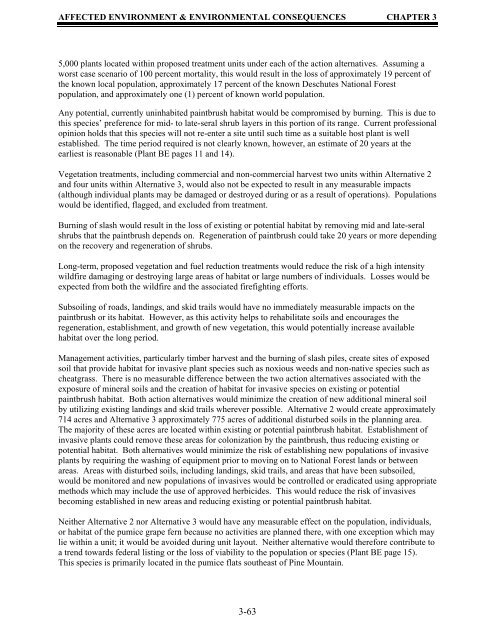Environmental Assessment
Environmental Assessment
Environmental Assessment
You also want an ePaper? Increase the reach of your titles
YUMPU automatically turns print PDFs into web optimized ePapers that Google loves.
AFFECTED ENVIRONMENT & ENVIRONMENTAL CONSEQUENCES CHAPTER 3<br />
5,000 plants located within proposed treatment units under each of the action alternatives. Assuming a<br />
worst case scenario of 100 percent mortality, this would result in the loss of approximately 19 percent of<br />
the known local population, approximately 17 percent of the known Deschutes National Forest<br />
population, and approximately one (1) percent of known world population.<br />
Any potential, currently uninhabited paintbrush habitat would be compromised by burning. This is due to<br />
this species’ preference for mid- to late-seral shrub layers in this portion of its range. Current professional<br />
opinion holds that this species will not re-enter a site until such time as a suitable host plant is well<br />
established. The time period required is not clearly known, however, an estimate of 20 years at the<br />
earliest is reasonable (Plant BE pages 11 and 14).<br />
Vegetation treatments, including commercial and non-commercial harvest two units within Alternative 2<br />
and four units within Alternative 3, would also not be expected to result in any measurable impacts<br />
(although individual plants may be damaged or destroyed during or as a result of operations). Populations<br />
would be identified, flagged, and excluded from treatment.<br />
Burning of slash would result in the loss of existing or potential habitat by removing mid and late-seral<br />
shrubs that the paintbrush depends on. Regeneration of paintbrush could take 20 years or more depending<br />
on the recovery and regeneration of shrubs.<br />
Long-term, proposed vegetation and fuel reduction treatments would reduce the risk of a high intensity<br />
wildfire damaging or destroying large areas of habitat or large numbers of individuals. Losses would be<br />
expected from both the wildfire and the associated firefighting efforts.<br />
Subsoiling of roads, landings, and skid trails would have no immediately measurable impacts on the<br />
paintbrush or its habitat. However, as this activity helps to rehabilitate soils and encourages the<br />
regeneration, establishment, and growth of new vegetation, this would potentially increase available<br />
habitat over the long period.<br />
Management activities, particularly timber harvest and the burning of slash piles, create sites of exposed<br />
soil that provide habitat for invasive plant species such as noxious weeds and non-native species such as<br />
cheatgrass. There is no measurable difference between the two action alternatives associated with the<br />
exposure of mineral soils and the creation of habitat for invasive species on existing or potential<br />
paintbrush habitat. Both action alternatives would minimize the creation of new additional mineral soil<br />
by utilizing existing landings and skid trails wherever possible. Alternative 2 would create approximately<br />
714 acres and Alternative 3 approximately 775 acres of additional disturbed soils in the planning area.<br />
The majority of these acres are located within existing or potential paintbrush habitat. Establishment of<br />
invasive plants could remove these areas for colonization by the paintbrush, thus reducing existing or<br />
potential habitat. Both alternatives would minimize the risk of establishing new populations of invasive<br />
plants by requiring the washing of equipment prior to moving on to National Forest lands or between<br />
areas. Areas with disturbed soils, including landings, skid trails, and areas that have been subsoiled,<br />
would be monitored and new populations of invasives would be controlled or eradicated using appropriate<br />
methods which may include the use of approved herbicides. This would reduce the risk of invasives<br />
becoming established in new areas and reducing existing or potential paintbrush habitat.<br />
Neither Alternative 2 nor Alternative 3 would have any measurable effect on the population, individuals,<br />
or habitat of the pumice grape fern because no activities are planned there, with one exception which may<br />
lie within a unit; it would be avoided during unit layout. Neither alternative would therefore contribute to<br />
a trend towards federal listing or the loss of viability to the population or species (Plant BE page 15).<br />
This species is primarily located in the pumice flats southeast of Pine Mountain.<br />
3-63
















